#1808 fashion
Explore tagged Tumblr posts
Text
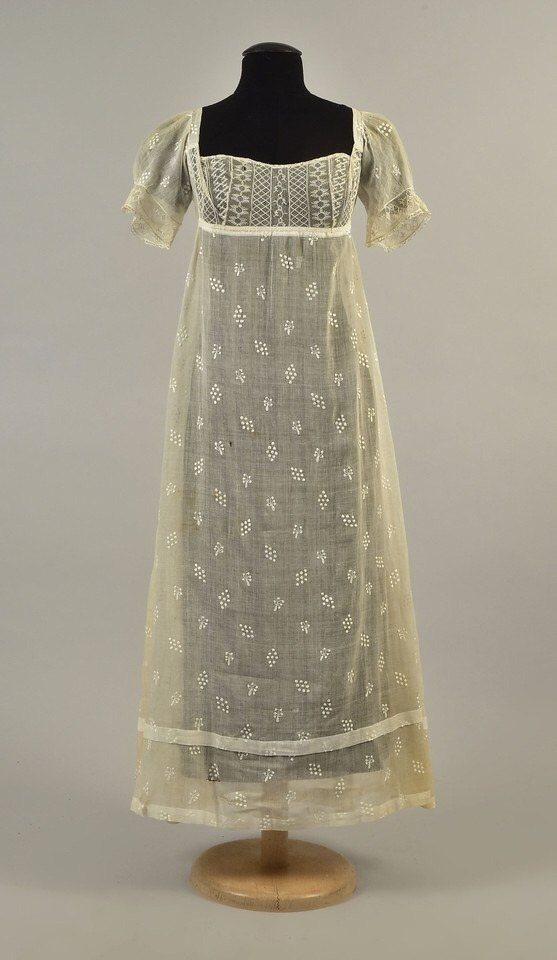

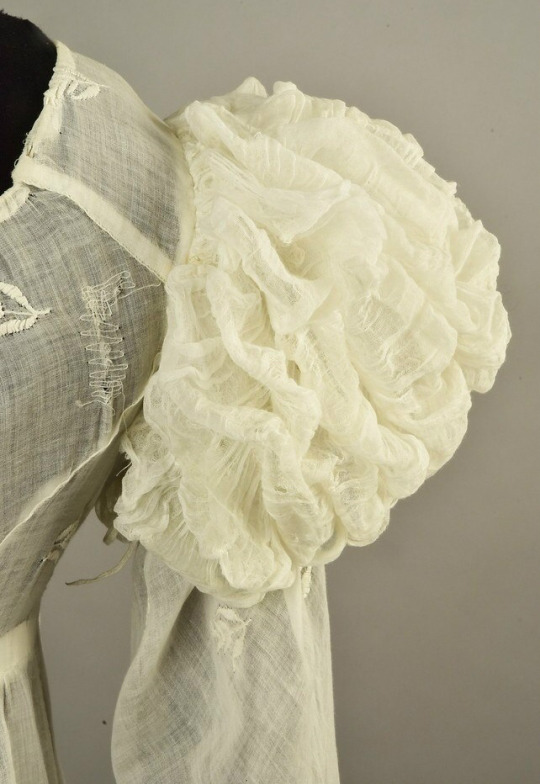
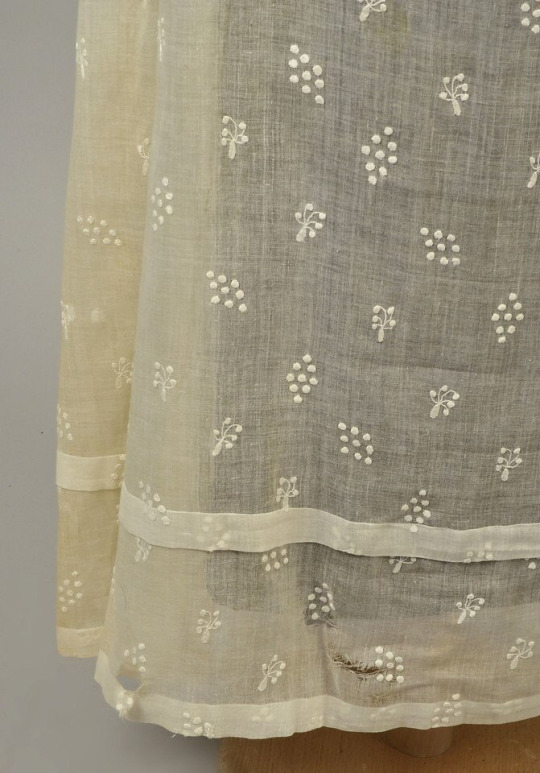

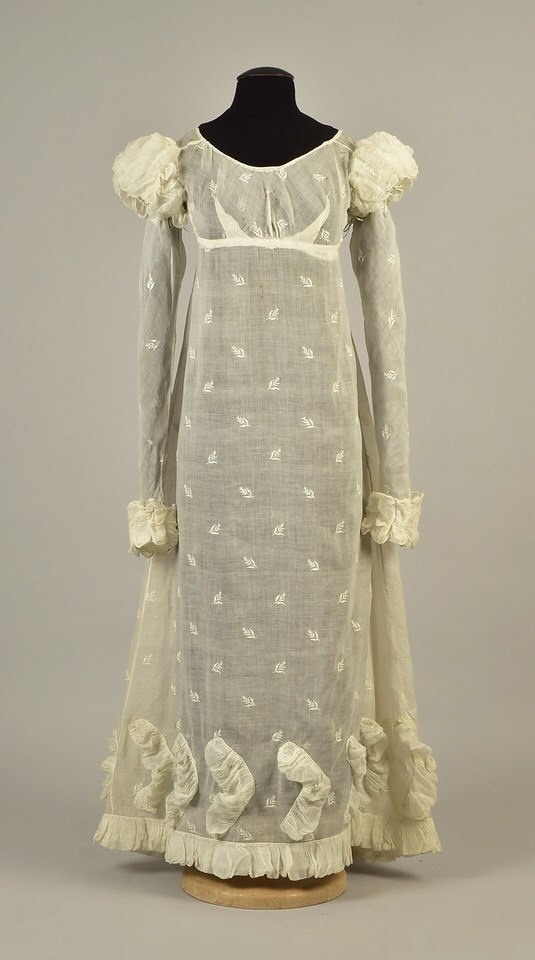
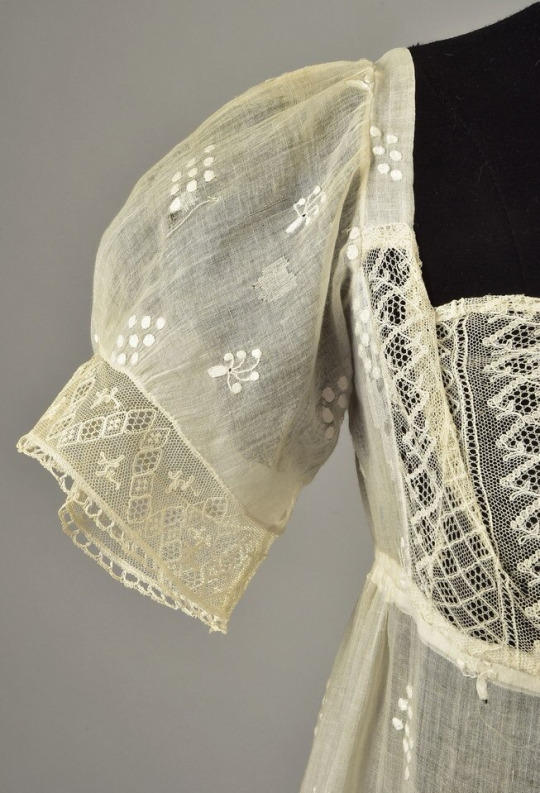
𝙻𝚘𝚟𝚎 🤍
𝚃𝚠𝚘 𝚖𝚞𝚜𝚕𝚒𝚗 𝚍𝚛𝚎𝚜𝚜𝚎𝚜 𝚍𝚎𝚌𝚘𝚛𝚊𝚝𝚎𝚍 𝚠𝚒𝚝𝚑 𝚎𝚖𝚋𝚛𝚘𝚒𝚍𝚎𝚛𝚢, 1808 𝚊𝚗𝚍 1815
#fashion #fashiongram #fashionable #fashionphotography #fashionlover #fashionart #fashionaddict #fashionphotographer #fashionpost #fashionshoot #fashionlove #fashionlovers #fashioneditoral #editoral #catwalk @bixlasagna
𝙵𝚊𝚋𝚕𝚎𝚜 & 𝙵𝚊𝚒𝚛𝚢𝚝𝚊𝚕𝚎𝚜 - 𝙳𝚎𝚗𝚒𝚣 𝙺𝚞𝚛𝚝𝚎𝚕 𝚁𝚎𝚖𝚒𝚡 𝚋𝚢 𝙽/𝚊, 𝚁𝚘𝚜𝚒𝚗𝚊 ✨

#l o v e#hand made#nostalgia#take me there for one day#muslim#muslin#dresses#3/2024#feminism#magick#muslin dresses#embroidery#1808#19th century#vintage#vintage fashion#art history#orient#oriental#1815#aesthetic#x-heesy#now playing#music and art#vintage dress#chic#fashion#we Need magick#arabic
353 notes
·
View notes
Text


submitted by @edwardian-girl-next-door 🩶🖤🤍🧡
#historical fashion poll submission#historical fashion polls#fashion poll#historical dress#historical fashion#dress history#fashion history#fashion plate#19th century#19th century fashion#19th century dress#early 19th century#1800s fashion#early 1800s#1800s#1800s dress#1808#skirt
91 notes
·
View notes
Text

Journal des Dames et des Modes, Costume Parisien, 15 mai 1808, (892): Chapeau de Paille, orné de Plumes et de Rubans Paille. Collier de Corail. Guêtres de Nankin. Collection of the Rijksmuseum, Netherlands
Woman, walking to the right, in a dress with short puffed sleeves, pleated collar and belt. On the head a straw hat decorated with feathers and straw ribbons. A coral necklace around the neck. Gaiters from 'nankin'. Further accessories: earring in the right ear, long gloves, fan, flat shoes. The print is part of the fashion magazine Journal des Dames et des Modes, published by Pierre de la Mésangère, Paris, 1797-1839.
#Journal des Dames et des Modes#19th century#18aughts#1808#on this day#May 15#periodical#fashion#fashion plate#color#description#rijksmuseum#dress
78 notes
·
View notes
Text

Embroidered muslin dress, English, 1808
From the Victoria & Albert Museum
#fashion#fashion history#history#dress#muslin#regency#1808#1800s#19th century#georgian#english#embroidery
46 notes
·
View notes
Text
The Truth Behind UAPs: Unidentified Anomalous Pussycats
In case you’ve been hiding under a rock—or maybe just too busy Googling “UFO vs. UAP” (spoiler alert: they’re the same thing)—let me enlighten you: the skies have never been busier. Every day, there’s a blurry video of “something” zipping through the air faster than a cat dodging a cucumber . But here’s the thing: maybe they’ve been living amongst us all along. This realisation hit me harder…
#Alien Abduction#Alien Cats#Alien Overlords#Cat Lovers Unite#Cat Rule#Cat Takeover#Cats Are From Venus#dailyprompt#dailyprompt-1808#Feline Conspiracy#Funny T-Shirt Design#Furry Overlords#Kitty Chronicles#Pet Humor#Sci-Fi Fashion#Sci-Fi Humor#UAP Sightings#UFO vs UAP#Venusian Cats
0 notes
Text
Honestly it's Past
Do you spend more time thinking about the future or the past? Why? If I may say honestly it’s PAST , because I don’t know why I regret that I have wasted my good time to be something in unnecessary things because of which right now I am in a situation where I have to struggle with daily life. Now I am trying to be more focused and be in the present and do what is needed so that my future is…
0 notes
Photo
Empire style dress during the Napoleonic era



1808 fashion doll by Madame Grès, 1949
#dress#fashion#pretty#empire#empire style#napoleonic#napoleonic era#19th century#1800s#1808#dresses#style#beauty#vintage#vintage fashion#antique#history of fashion#historical fashion#19th c. costume#empire period#costume
105 notes
·
View notes
Text
in looking at fashion plates while pondering Ye Olde Pixie Cut (one of two acceptable hair options for 19th-century adult female characters in period dramas if they're out in public, IMO, the other being Put That Goddamn Hair Up In A Becoming And Personally Expressive Manner Right Now) I found this lady from an 1808 edition of Costume Parisien who shows up at your party and starts playing Wonderwall on the pianoforte

#no honestly it's very pretty. it's just also rather Sensitive Early 2010s Proto-Hipster#regency#directoire#fashion history
77 notes
·
View notes
Text
Pink is for Boys
"Pink or Blue? Which is intended for boys and which for girls? This question comes from one of our readers this month, and the discussion may be of interest to others. There has been a great diversity of opinion on this subject, but the generally accepted rule is pink for the boy and blue for the girl. The reason is that pink, being a more decided and stronger color, is more suitable for the boy, while blue, which is more delicate and dainty, is prettier for the girl." ~ The Infants' Department, June 1918

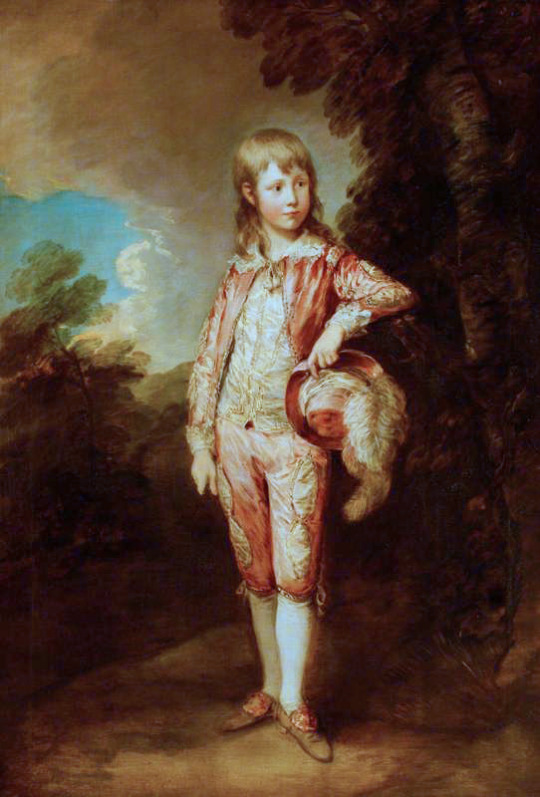
[Left: The Blue Boy, oil on canvas, c. 1770, by Thomas Gainsborough.
Right: The Pink Boy, oil on canvas, c. 1782, by Thomas Gainsborough.]
Pink is for girls and blue is for boys. But it hasn't always been this way. Colour coding infants as a way of denoting gender was popular in 20th century America. The problem? Pink and blue? Which is for boys and which is for girls?
In 1927 TIME Magazine asked ten of the "leading stores that sell baby equipment" which colour was for which gender. Four stores responded pink for girls and blue for boys; Macy's (Manhattan), Franklin Simon (Manhattan), Wanamaker's (Philadelphia) and Bullock's (Los Angeles). Five stores responded pink for boys and blue for girls; Best's (Manhattan), Marshall Field's (Chicago), Filene's (Boston), Maison Blanche (New Orleans) and The White House (San Francisco). Curiously Halle's (Cleveland) responded that pink was for both boys and girls.
This debate would continue and it wasn't until mid-20th century that pink for girls and blue for boys became firmly cemented in western culture.
However the idea of colour coding infants dates back to the 19th century. According to La cour de Hollande sous le règne de Louis Bonaparte in 1808 in Holland pink was used to announce the birth of a girl and blue a boy. In March 1856 Peterson's Magazine (Philadelphia, USA) advises that the ribbon on a christening cap should be blue for a boy and pink for a girl. On the 23rd of July 1893 the New York Times writes that for baby clothes it's "pink for a boy and blue for a girl!"

[The Oddie Children, oil on canvas, c. 1789, by William Beechey, via North Carolina Museum of Art.]
During the latter half of the 18th century one of the most popular outfits for young children, regardless of gender, was a white dress with a coloured sash tied around the waist. Pink and blue being the most popular colours, although other colours were worn as well. It would be tempting to assume that the colour of the sash indicated gender but there isn't clear evidence that this was the case. The Oddie Children (above) depicts Sarah, Henry, Catherine, and Jane Oddie. The three girls are all wearing white dresses; two with a blue sash one with a pink sash. We also see Henry Russell (bellow left) wearing a blue sash and Prince William (bellow right) wearing a pink sash.
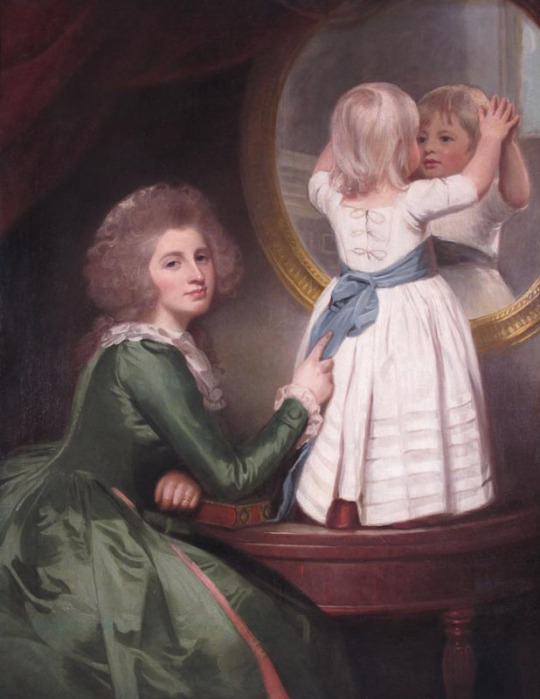
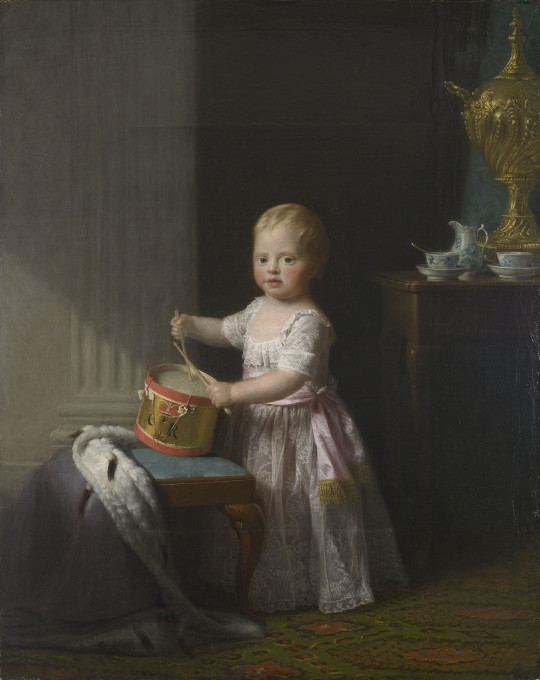
[Left: Anne Barbara Russell née Whitworth with her son Sir Henry Russell, oil on canvas, c. 1786, by George Romney, via Woolley & Wallis.
Right: Prince William, oil on canvas, c. 1767, by Allan Ramsay, via the Royal Collection Trust.]
Pink was just one of the many colours popular in 18th century English womenswear and seems to have stayed popular throughout the century. On the 3rd of January 1712 The Spectator published an article in which a man recalls seeing "a little Cluster of Women sitting together in the prettiest coloured Hoods that I ever saw. One of them was Blew, another Yellow, and another Philomot; the fourth was of a Pink Colour, and the fifth of a pale Green". On the 1st of May 1736 the Read's Weekly Journal, or British Gazetteer reports that the ladies attending the royal wedding wore gowns of "Gold stuffs, or rich Silks with Gold or Silver Flowers, or Pink or White Silks, with either Gold or Silver Netts or Trimmings;" shoes either "Pink, White or Green Silk, with Gold or Silver Lace and braid all over." On the 24th of May 1785 Charles Storer writes to Abigail Adams advising that fashionable colours in English court dress are "pink, lilac, and blue" such "as is worn at Versailles".
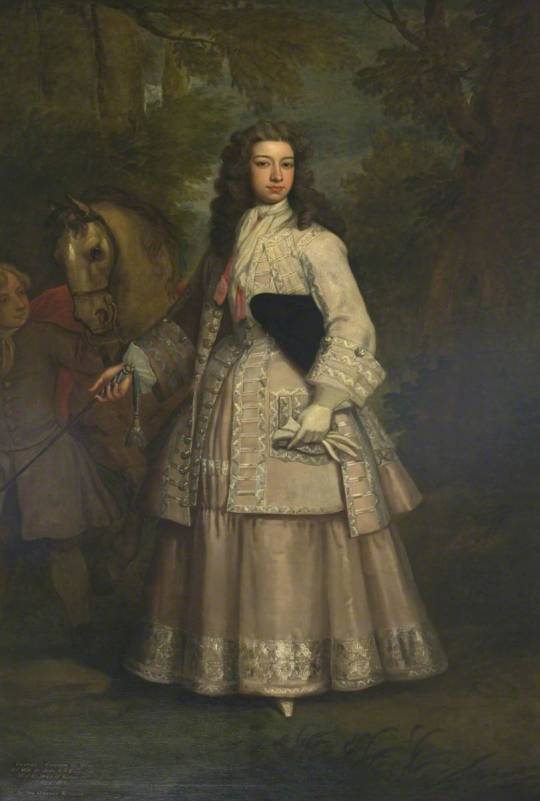
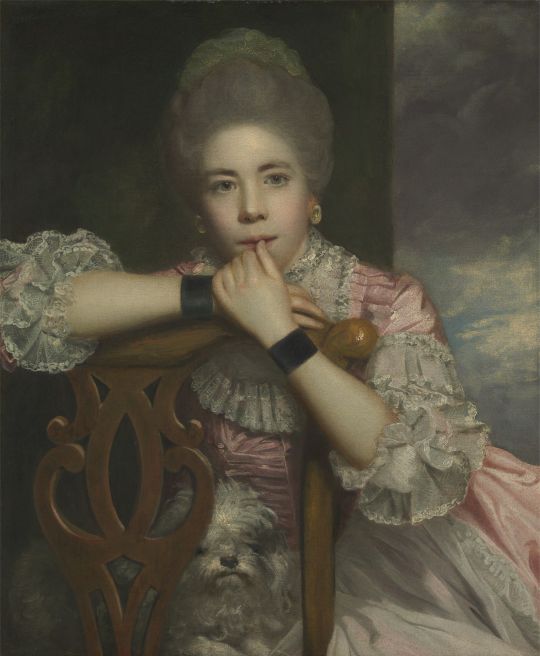
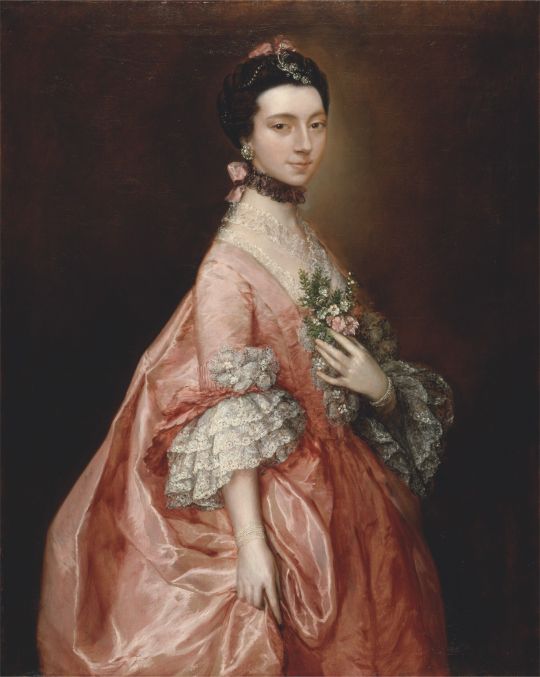
[Left: Frances, Daughter of Evelyn Pierpont, 1st Duke of Kingston, oil on canvas, c. 1700-23, by Godfrey Kneller, via Art UK.
Middle: Mrs. Abington as Miss Prue in "Love for Love" by William Congreve, oil on canvas, c. 1771, by Sir Joshua Reynolds, via Yale Center for British Art.
Right: Mary Little, later Lady Carr, oil on canvas, c. 1765, by Thomas Gainsborough, via Yale Center for British Art.]
In particular pink was popular amongst young women as the colour was associated with youth. Older women who wore pink were mocked as vain for dressing in a way that was seen as improper for their age. On the 31st of January 1754 Lady Jane Coke writes to Mrs. Eyre criticising old women who wear pink:
As for fashions in dress, which you sometimes inquire after, they are too various to describe. One thing is new, which is, there is not such a thing as a decent old woman left, everybody curls their hair, shews their neck, and wears pink, but your humble servant. People who have covered their heads for forty years now leave off their caps and think it becomes them, in short we try to out-do our patterns, the French, in every ridiculous vanity.
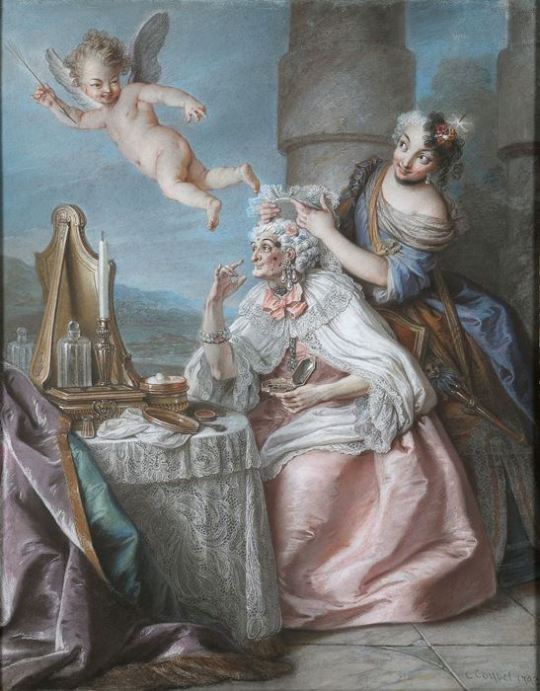
[Folly Embellishing Old Age With the Adornments of Youth, oil on canvas, c. 1743, by Charles-Antoine Coypel, via Master Art.]
For Englishmen acceptable clothing way much more limited. In A Foreign View of England in the Reigns of George I & George II Monsieur César de Saussure writes that Englishmen "do not trouble themselves about dress, but leave that to their womenfolk". He explains:
Englishmen are usually very plainly dressed, they scarcely ever wear gold on their clothes; they wear little coats called "frocks," without facings and without pleats, with a short cape above. Almost all wear small, round wigs, plain hats, and carry canes in their hands, but no swords. Their cloth and linen are of the best and finest. You will see rich merchants and gentlemen thus dressed, and sometimes even noblemen of high rank, especially in the morning, walking through the filthy and muddy streets.
César de Saussure warns that "a well-dressed person in the streets, especially if he is wearing a braided coat, a plume in his hat, or his hair tied in a bow, he will, without doubt, be called "French dog" twenty times perhaps before he reaches his destination" and is not only at risk of "being jeered at" but also "being bespattered with mud, but as likely as not dead dogs and cats will be thrown at him."
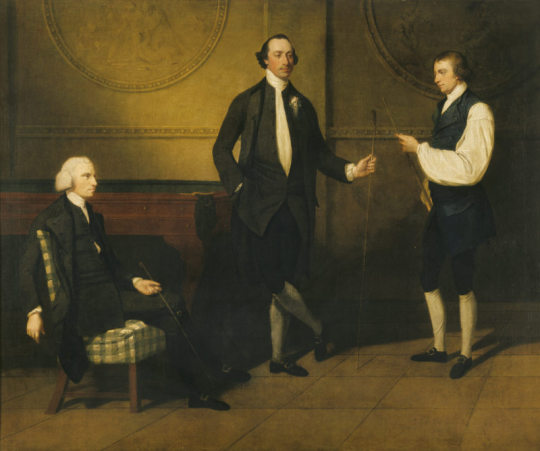
[Reverend Charles Everard Booth, Captain Griffith Booth, and an Unidentified Man playing Billiards, oil on canvas, c. 1775-9, by John Hamilton Mortimer, via the Royal Collection Trust.]
For Englishmen dressing "plainly" mostly meant wearing blacks and browns. In his book on macaroni, Pretty Gentleman, Peter McNeil found that in contrast most English menswear that he describes as generally consisting of "monochrome broadcloth" macaroni wore a variety of colours including green, orange, yellow, violet, red, white, blue, gold, silver and of course pink.
But it's not just the macaroni of the 1770s & 1780s that wore pink. We see pink in descriptions of feminine men's dress (both real and fictional) throughout the 18th century.
On the 2nd of June 1722 Sarah Osborn writes to Robert Byng:
I believe the gentlemen will wear petticoats very soon, for many of their coats were like our mantuas. Lord Essex had a silver tissue coat, and pink color lutestring waistcoat, and several had pink color and pale blue paduasoy coats, which looked prodigiously effeminate.
On the 18th of October 1729 the Universal Spectator and Weekly Journal published a story where an "effeminate" man's clothes were described as follows:
He had a flower'd pink-colour Silk Coat, with a Green-Sattin Waistcoat lac'd with Silver. Velvet Breeches, Clock'd Stockings the Colour of his Coat, Red-heel'd Pumps, a Blue Ribbon at the Collar of his Shirt, and his Sword-Hilt he embrac'd under the Elbow of his Left Arm,

[Sir Miles Stapylton, 4th Bt of Myton, oil on canvas, c. 1730-35, via Art UK.]
In The Adventures of Roderick Random (1748) the effeminate (and queer coded) Captain Whiffle is described as follows:
our new commander came on board in a ten-oared barge, overshadowed with a vast umbrella, and appeared in everything the reverse of Oakum, being a tall, thin young man, dressed in this manner: a white hat, garnished with a red feather, adorned his head, from whence his hair flowed upon his shoulders, in ringlets tied behind with a ribbon. His coat, consisting of pink-coloured silk, lined with white, by the elegance of the cut retired backward, as it were, to discover a white satin waistcoat embroidered with gold, unbuttoned at the upper part to display a brooch set with garnets, that glittered in the breast of his shirt, which was of the finest cambric, edged with right Mechlin: the knees of his crimson velvet breeches scarce descended so low as to meet his silk stockings, which rose without spot or wrinkle on his meagre legs, from shoes of blue Meroquin, studded with diamond buckles that flamed forth rivals to the sun! A steel-hilted sword, inlaid with gold, and decked with a knot of ribbon which fell down in a rich tassel, equipped his side; and an amber-headed cane hung dangling from his wrist. But the most remarkable parts of his furniture were, a mask on his face, and white gloves on his hands, which did not seem to be put on with an intention to be pulled off occasionally, but were fixed with a curious ring on the little finger of each hand.

[Henry Ingram, 7th Viscount Irwin and His Wife Anne, oil on canvas, c. 1745, by Philippe Mercier, via Art UK.]
On the 28th of July 1780 the London Courant reports:
A few days ago, a Macaroni made his appearance in the Assembly-room at Whitehaven, in the Following dress: a mixed silk coat, pink sattin waistcoat and breeches, covered with an elegant silver nett, white silk stockings with pink clocks, pink sattin shoes and large pearl buckles, a mushroom coloured stock, covered with a fine point lace; his hair dressed remarkably high, and stuck full of pearl pins.
On the 6th of August 1792 The Weekly Entertainer published Sketches and Portraits form the Life by Simon Tueopnrastus which included the following description:
Mercator was a youth of some genius and expectation, but by a strange perverseness of disposition, notwithstanding the extreme natural stiffness of his limbs, he had acquired an early attachment to the most finical and effeminate finery; so that, while yet a boy, he would exhaust every expedient of a fertile invention to procure a laced waistcoat, or the most foppish toy; would dangle a watch-string, with brass seals, from each fob, at a time when the frugal care of his parents would not permit him to wear a watch in either; and would strut in a fine pair of second-hand pink silk breeches, and a light blue coat, with all the formal dignity of—a soldier upon the parade.


[Left: Thomas King in "The Clandestine Marriage", oil on canvas, c. 1792, by Samuel De Wilde, via Yale Center for British Art.
Right: Edward Payne, oil on canvas, by Arthur Devis, via Art UK.]
While pink is mentioned in these descriptions of feminine men's dress it's not singled out as the girl colour the way pink would become in the 20th century. I would argue pink is seen as effeminate not because pink is a uniquely feminine colour but because it was used in fashionable dress. In 18th century England being interested in fashion was seen as an frivolous female trait. Men who showed too much interest in fashion were mocked and ridiculed for their gender nonconformity. "A Man must sink below the Dignity of his Nature, before he can suffer his Thoughts to be taken up on so trivial an Affair, as the Chosing, Suiting, and Adjusting the Adornments of his Person," complains a letter published on the 8th of May 1731 in Read's Weekly Journal, or British Gazetteer:
Decency of Garb ought inviolably to be preserved; nor can there be possibly an Excuse for Dressing like a Merry-Andrew: Rich and coloured Silks are in themselves effeminate, and unbecoming a Man; as are, in short, all Things that discover Dress to have been his Study 'Tis in vain for a Fop of Quality, to think his Title will protect him.


[Left: Madame de Pompadour (detail), oil on canvas, c. 1756, by François Boucher, via Alte Pinakothek.
Right: Elizabeth Wrottesley, later Duchess of Grafton, oil on canvas, c. 1764-5, by Thomas Gainsborough, via National Gallery of Victoria.]
English fashion was highly influenced by French fashion. A popular colour scheme in French fashion was green and pink. A famous example of this colour pairing can be seen in François Boucher's portrait of Madame de Pompadour (above left), she is depicted in a green gown with pink bows and flowers. You can see and example of how this style inspired English fashion in Thomas Gainsborough's portrait of Elizabeth Wrottesley (above right), who is depicted in a green gown with a floral pattern adorned with pink, white and green striped bows.
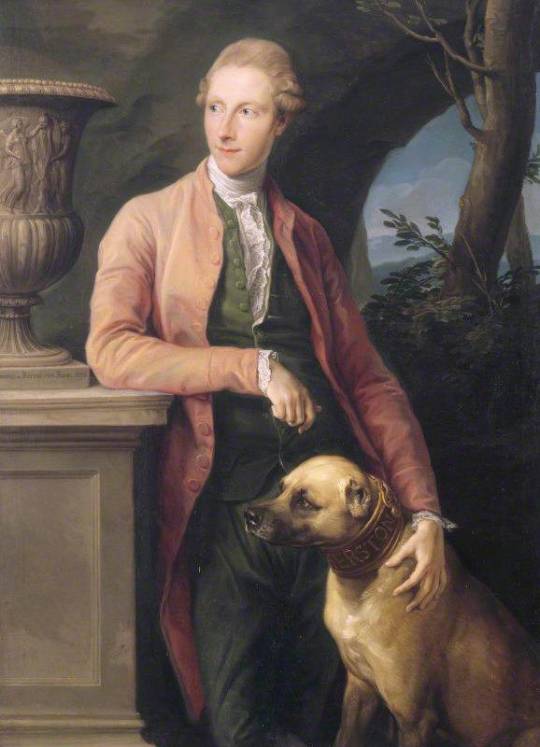
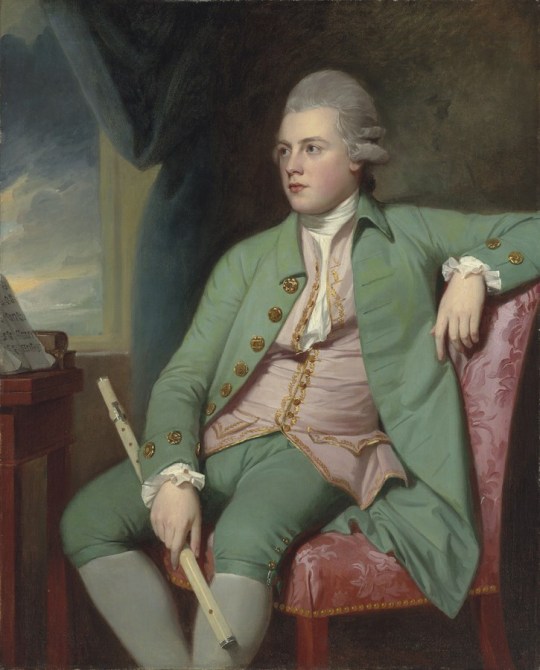
[Left: Sir Harry Fetherstonhaugh, oil on canvas, c. 1776, by Pompeo Batoni, via Wikimedia.
Right: Francis Lind, oil on canvas, c. 1775, by George Romney, via Mackinnon Fine Art.]
Fashionable Englishmen were also inspired by these French designs. Horace Walpole refers to the popularity of the colour combination writing to Lady Ossory on the 19th of February 1774 "If I went to Almack's and decked out my wrinkles in pink and green like Lord Harrington, I might still be in vogue". Almack's is referring to Almack's Assembly Rooms on Pall Mall which is believed to be the inspiration for the Macaroni Club. (see Pretty Gentleman by Petter McNeil p52-55) In a letter to Lord Harcourt on the 27th of July 1773 Walpole writes of "Macaronis lolling out of windows at Almack's like carpets to be dusted."
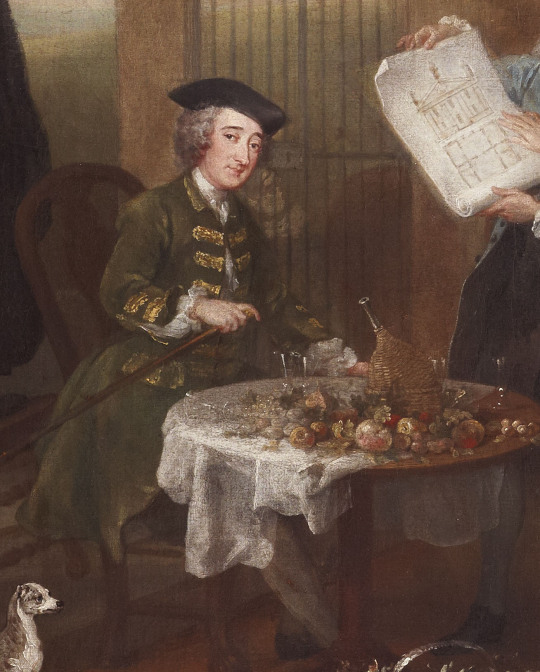

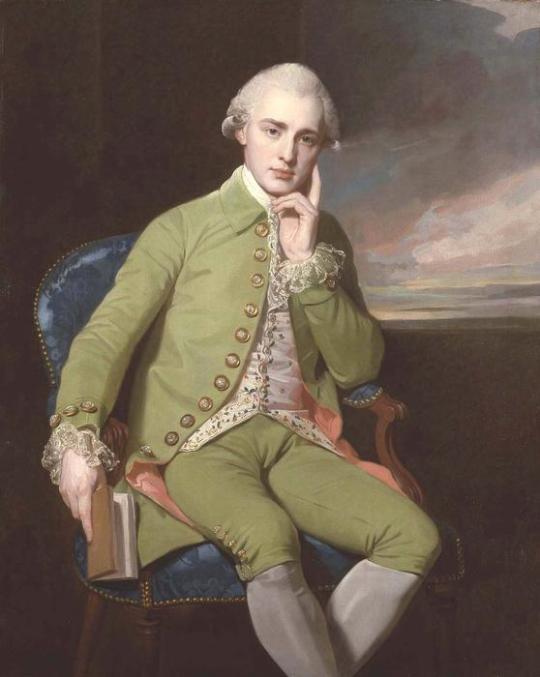
[Left: Detail of Stephen Fox from The Hervey Conversation Piece, oil on canvas, c. 1738-40, by William Hogarth, via Fairfax House.
Middle: Sir William Jones, oil on canvas, c. 1769, by Francis Cotes, via Art UK.
Right: Portrait of a Gentleman, oil on canvas, by George Romney.]
Men who wore green seem to have been just as much, if not more, at risk of being ridiculed, or even assaulted, for the colour of their clothes as those who wore pink. In Pierre Jean Grosley's A Tour to London (originally published 1772) he recalls traveling with a young English surgeon who was harassed by Londoners due to his green French frock coat:
At the first visit which he paid me in London, he informed me, that, a few days after his arrival, happening to take a walk thro' the fields on the Surry side of the Thames, dressed in a little green frock, which he had brought from Paris, he was attacked by three of those gentlemen of the mobility, who, taking him for a Frenchman, not only abused him with the foulest language, but gave him two or three slaps on the face: "Luckily, added he in French, I did not return their ill language; for, if I had, they would certainly have thrown me into the Thames, as they assured me they would, as soon as they perceived I was an Englishman, if I ever happened to come in their way again, in my Paris dress."
244 notes
·
View notes
Text
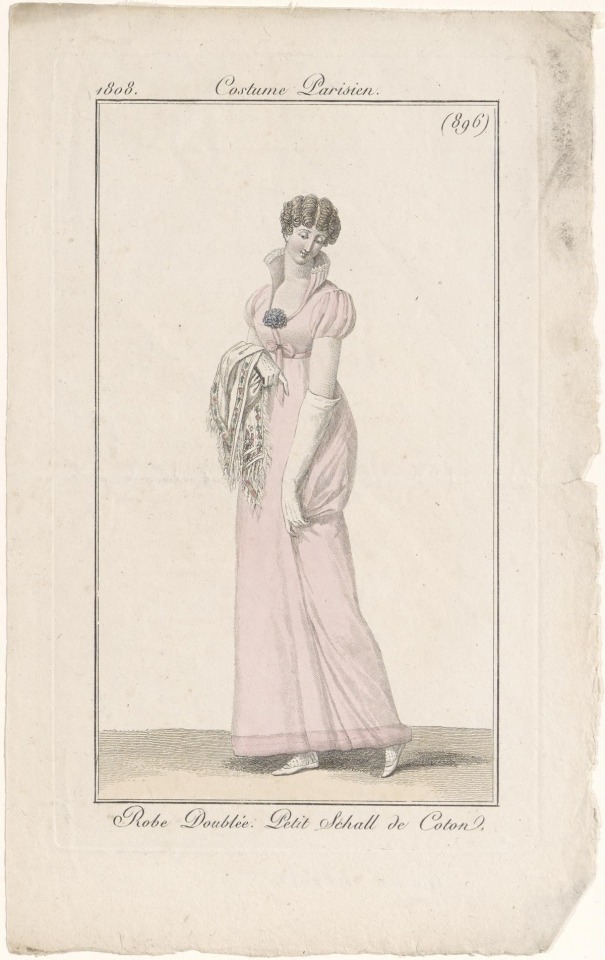
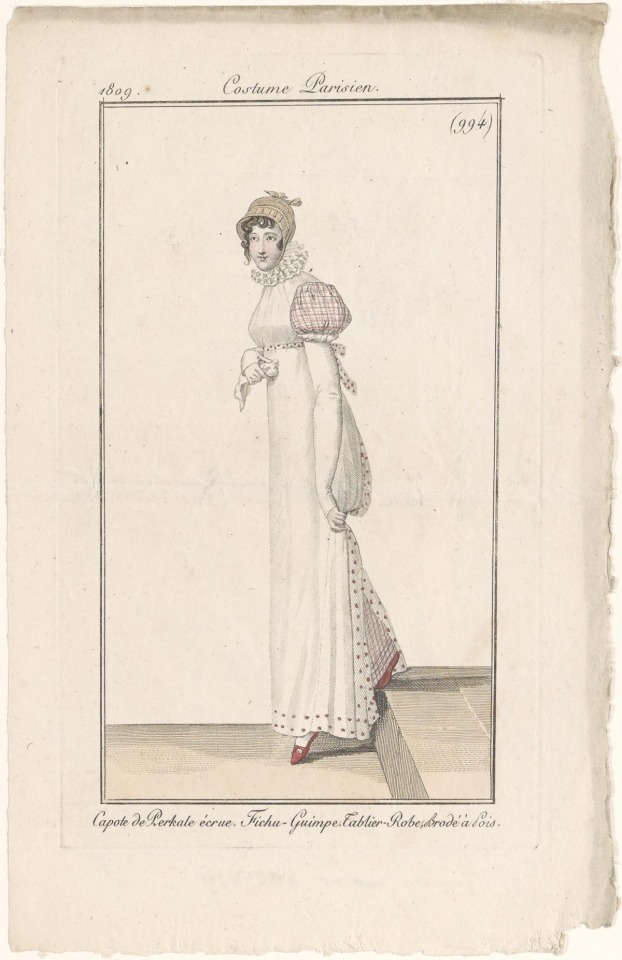
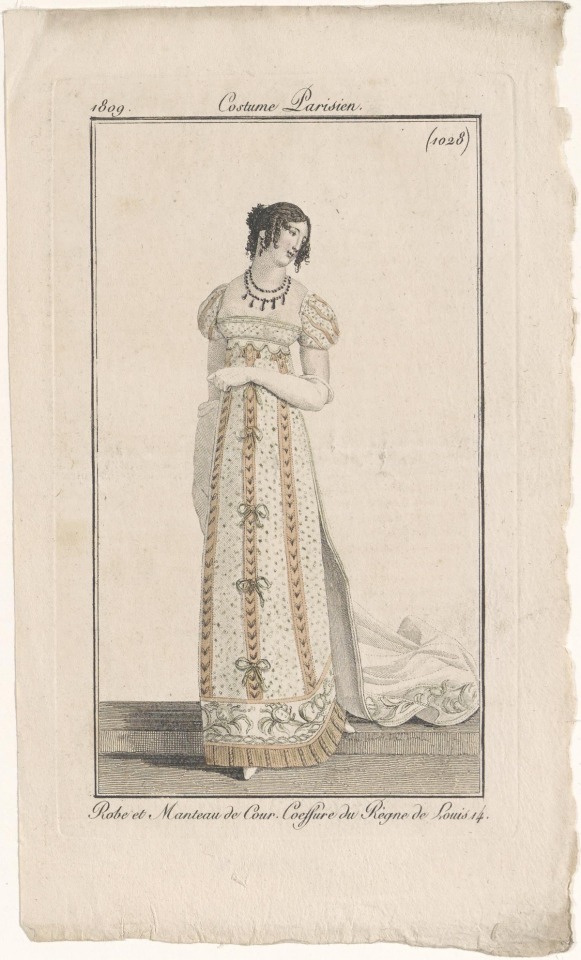


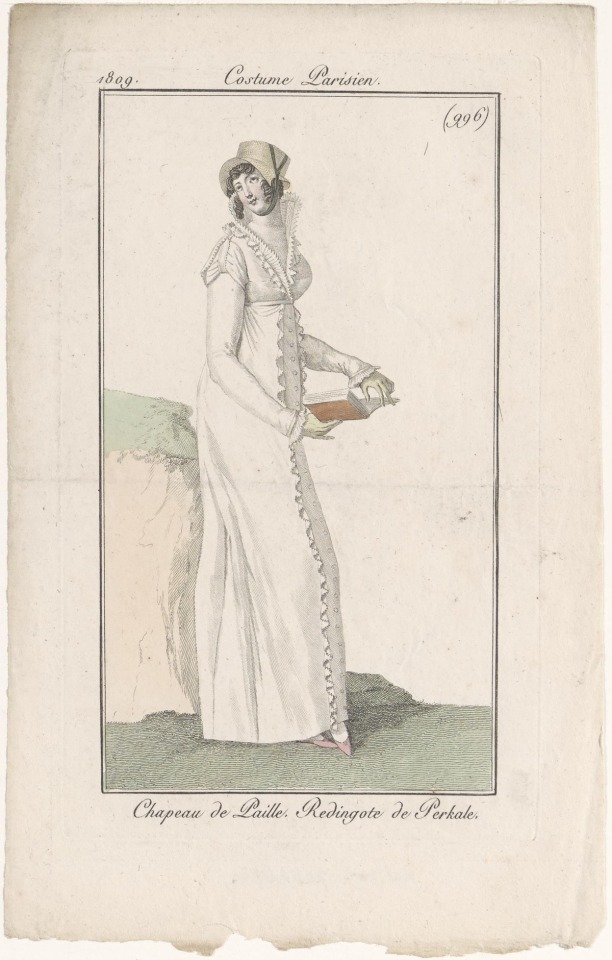
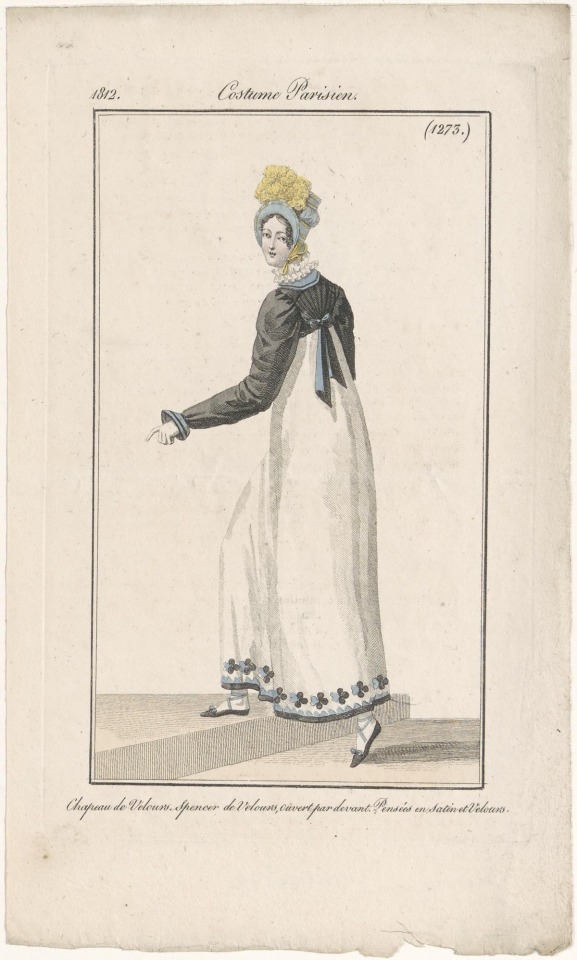
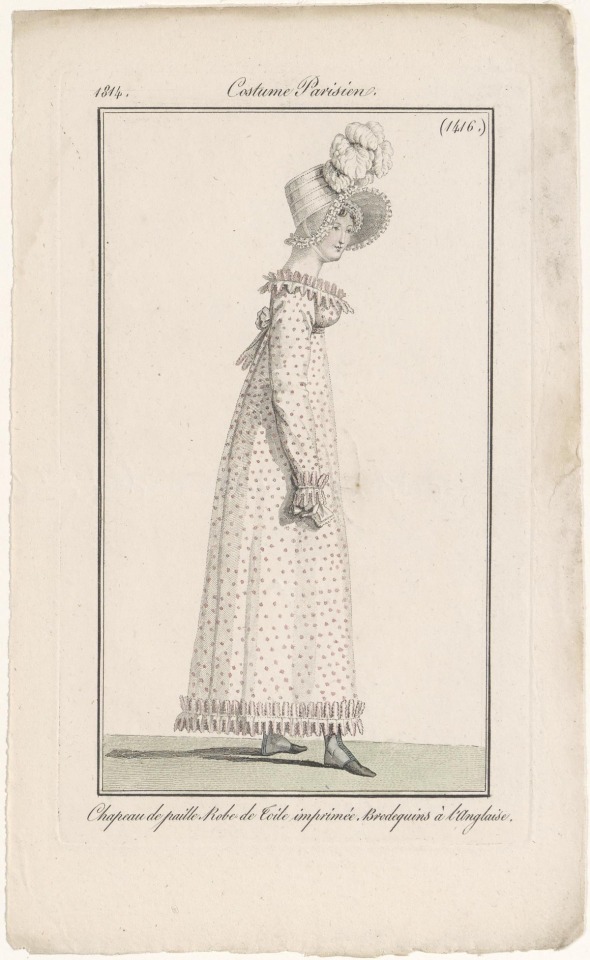
Fashion prints from Journal des Dames et des Modes
1808-1814, Napoleonic era
CMU
#fashion plates#fashion prints#prints#fashion#Journal des Dames et des Modes#Napoleonic era#napoleonic#napoleon#first french empire#napoleon bonaparte#1800s#1800s fashion#19th century fashion#historical fashion#history of fashion#art#centraal museum#Netherlands#french empire#mode#regency#regency era#regency fashion#Jane Austen#print#pretty#France#empire style#empire
307 notes
·
View notes
Text

Portrait of Félicité-Louise de Durfort, Maréchale de Beurnonville
Artist: Merry Joseph Blondel (French, 1781-1853)
Date: 1808
Medium: Oil on Canvas
Collection: Private Collection
Description
Félicité-Louise de Durfort (1782-1870) was the youngest daughter of Count de Durfort, the pre-Revolutionary French Ambassador of France to the Republic of Venice (where died in exile in 1801). She is depicted standing in a simple high-waisted white dress, the splendid cashmere shawl draped over her right arm falling to the ground where the sun streams across it. Her hair is done in the latest fashion, while she is partially shaded by the splendid orange tree against whose large, painted wooden pot she is leaning. To the left we see some steps leading down to a winding path with a distant view of the Château of Balincourt.
#portrait#female#full length#standing#oil on canvas#fine art#painting#woman#high waisted dress#cashmere shawl#orange tree#wooden pot#steps#path#chateau balincourt#garden#merry joseph blondel#french painter#flowers#19th century painting
25 notes
·
View notes
Text

God help us – for art is long and life is short! (Faust: First Part, written by Johann Wolfgang Goethe and published in 1808)
hiiii heres the first part of what will (hopefully!!!) be a series of western women's fashion from 1800 to today. obviously, not all women looked like this or dressed like this. in fact, most didn't - these are largely going to be looks worn by women of a higher socioeconomic class, at least until maybe the 1880s. this is for a few reasons, mostly being, uh... availability of cc. i'd love to MAKE some historical cc but my laptop won't run blender. another reason is that the fashion of the upper classes is typically better recorded than that of lower classes, especially before the advent and popularization of photography. i'm just rambling now.
anyway! the first part: 1800-1809. we see the opulence of the georgians cling onto fashion in bows, feathers, and jewels. we also see the rise of waistlines to the iconic empire waist, and the influences of neoclassical aesthetics in fashion. hairstyles in particular were emulating those of the ancient greeks, also pulling a bit from the stuarts. this decade also allows me to share one of my favorite tidbits of fashion history: the coiffure à la titus! for a short time in the 1790s through the 1810s, some women (french women especially) took to cutting their hair short and choppy. the reasons range from inspiration taken from a popular play at the time, to symbolizing solidarity with women executed via guillotine. some men at the time thought that having short hair was actually hazardous to women's health, so while the titus cut wasn't the norm, it was widespread enough to cause quite a storm!
you'll notice that 1806 is missing. that's because the dress i used, uh... completely messed up the arms and i did not notice until i was making the gif. if you wanna see it, it'll be under the cut.
cc links + creator tags under the cut!!
see my resources page!
adelais : clepysdra's padme snail hair / ice-creamforbreakfast's vittoria pendant / hanalinori's morning in the garden dress / oydis' willow armlets / oydis' eloise flats
aelita : plasma-jane's athena hair, updated by my-historical-sims / s-clubs laurel crown (tsr download) / kaguya-fox's nioh oichi hair branch / simsonico's shining nikki shy lady dress conversion / dancemachinetrait's lydia flats
alanis : peebsplays' regency bun / joliebean's joanna earrings / leeleesims1's throw it on accessory wrap / dissia's amy accessory sleeves (tsr download) / zeussims' estrella gown
amalthea : simsonico's shining nikki shy lady headband conversion / mothz's accessory necktie / serenity-cc's accessory frilled turtleneck / sifix's hope dress (tsr download) / simsonico's shining nikki reminiscence of flower fan conversion
anamarija : okruee's cicero hair / pixelunivairse's pearls necklace / gilded-ghosts' bingley gown / maushasi's acc. lace top (search 'lace', accessory included in file) / dancemachinetrait's pemberley gloves / leonalure's transparent priestess scarf or here (REUPLOAD, original download on shady site. leonalure – if you see this and want me to take it down, just let me know!!) / dancemachinetrait's lydia flats
aoide : teanmoon's helen updo / zeussims' dreamer earrings / gilded-ghosts' highbury chemisette / sifix's giselle dress (tsr download) / dancemachinetrait's pemberley gloves
arden : bedisfull's feel my rhythm rose straw hat / izuko's urban animal faux fur scarf / gilded-ghosts' emma gown / dissia's ayiana accessory sleeves (tsr download) / simsonico's shining nikki reminiscence of flower fan conversion / joliebean's satin tip shoes
astrid : sadlydulcet's set 22 hat (search 'set #22') / nightingalesongx's low side bun / simsonico's shining nikki shy lady necklace conversion / dancemachinetrait's pemberley gloves / simsbrush's regency dress / dancemachinetrait's kitty flats
azucena : buzzardly28's gesina hair v2 / magnolianfarewell's venus dress / dustyratt's emma frost cape / dancemachinetrait's pemberley gloves / dancemachinetrait's kitty flats
thanks to @clepysdra @ice-creamforbreakfast @hanalinori @oydis @my-historical-sims @plasma-janes @kaguya-fox @simsonico @dancemachinetrait @peebsplays @joliebean @leeleesims1 @dissiasims @zeussims @serenity-cc @okruee @pixelunivairse @gilded-ghosts @teanmoon @bedisfull @nightingalesongx @simsbrush @buzzardly28 @magnolianfarewell and @dustyratt
(heres the failed 1806)
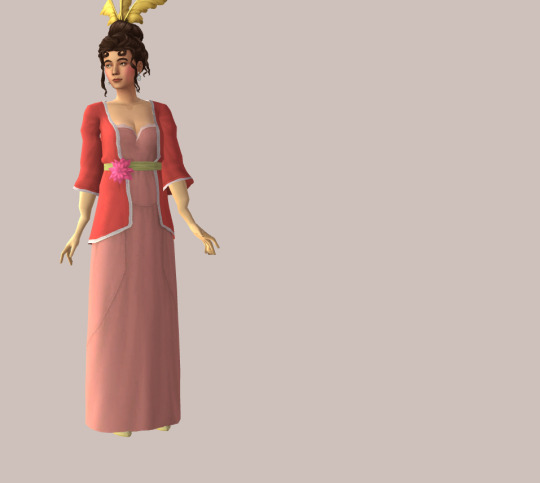
#my sims#sims 4 lookbook#sims 4 regency lookbook#ts4 regency#223 years#1800s#georgian#regency#historical
149 notes
·
View notes
Text




"The History of Sleigh Bells"
Jingle Bells Rock! As always they too have a history relating to Christmas.. here's the story.
*Horse-bell Heyday: 1800s
In the 1800s, horse bells were used for wintertime recreation as well as for work. Winter "pleasure drives" required fashionably warm clothes, handsome sleighs, well-groomed horses, and nicely polished harnesses and bells. This strong association of horse bells with Christmas and winter fun led people to gradually call them "sleigh bells" instead.
Sleighbells became a part of popular culture, leading to songs, stories, and poetry about them. The most popular example is the song
"One Horse Open Sleigh", known today as "Jingle Bells". It was written by James Lord Pierpont in 1857.
Another example, not as well known, is the poem "Sleigh Bell" written by Yakov Polonsky in 1854.
The U.S. sleigh bell industry began to grow strongly in the early 1800s. William Barton started the sleigh bell industry in East Hampton, Connecticut, USA, about 1810. Barton's willingness to teach the sleigh bell trade to others was a key reason why East Hampton earned worldwide fame as "Belltown" or "Jingletown" in the 1800s.
"...The manufacturing enterprise of East Hampton and its general prosperity are traceable to no one man more than to William Barton...
He came to East Hampton in 1808 and began making handbells and sleigh bells. Others learned the trade with him, and afterwards engaged in the same business...."
Other individuals contributed to East Hampton's fame later in the century:
"...By the end of the 1800s, East Hampton bell maker N. N. Hill had developed a process of stamping sleigh bells out of sheet metal... While casting bells, two skilled workmen could make about 500 bells in one day. with stamping, one man can produce 25,000 bells!...
"In 1839, the total number of bells manufactured in East Hampton was reported at about 14,000 sleigh bells and house bells combined. Only 11 years later, an 1850 industrial census reported the annual total of sleigh bells made in town jumped to '245,000 dozen,' almost three million bells....
"By the late 1800s, the many bell makers of East Hampton provided 90% of the world's sleigh bells...."
Bell manufacturers in the East Hampton area during the 1800s included William Barton, sons Hiram and Hubbard Barton, Bevin Bros. Mfg. Co., Gong Bell Co., East Hampton Bell Co., N. N. Hill Brass Co., Starr Brothers, Veazey & White, and W. E. Barton & Clark (W.E. was William Barton's grandson.)
East Hampton manufacturers, while prolific, were not the only ones making bells in the U.S. By the late 1800s, bell foundries throughout the East and Midwest produced a dizzying variety of sleigh bells and many different ways to put sleigh bells on horses and their vehicles. That's the Jinglee story!
12 notes
·
View notes
Text
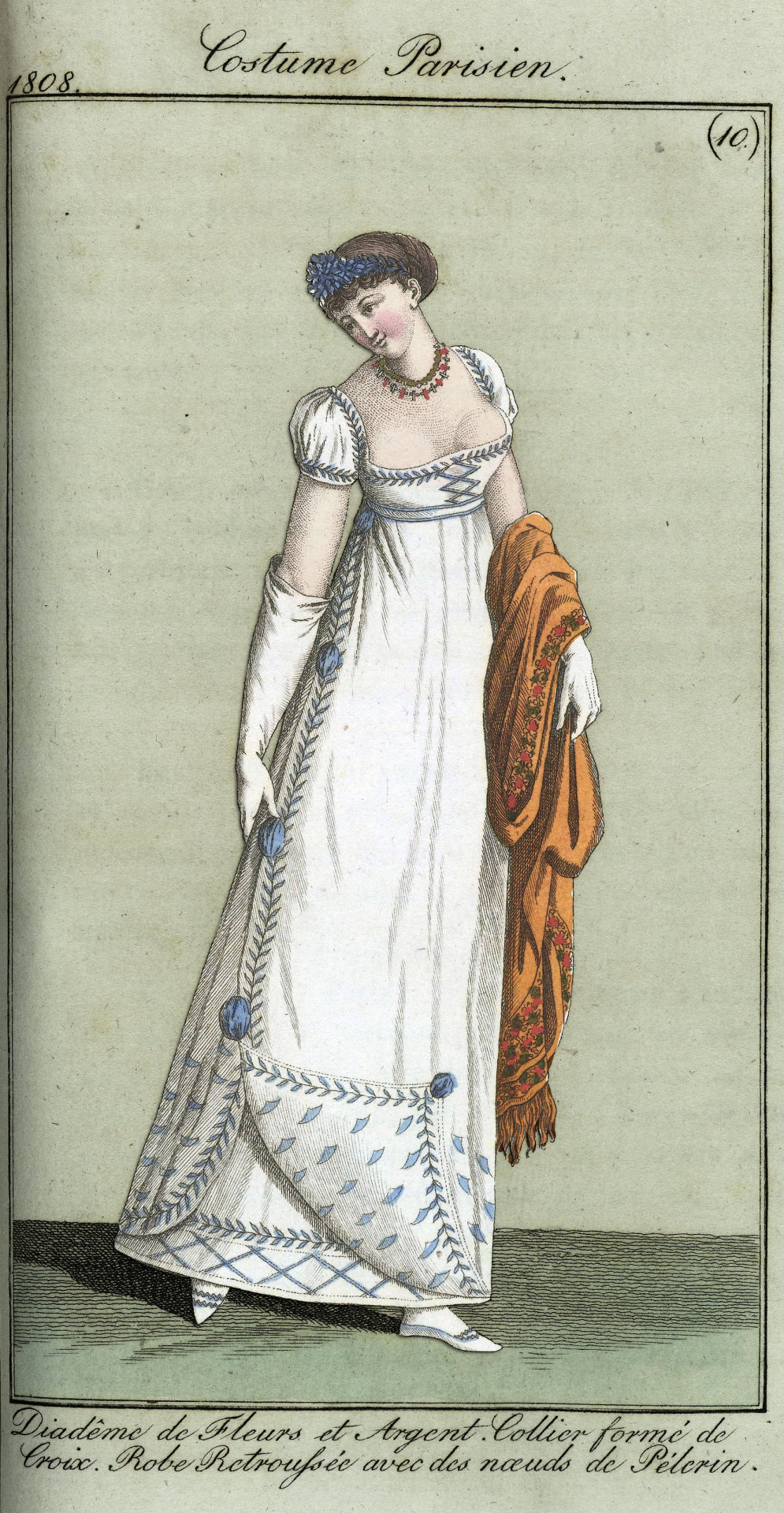
Journal des Dames et des Modes, editie Frankfurt 7 mars 1808, Costume Parisien (10): Diadême de Fleurs et Argent. Collier formé de Croix. Robe Retroussée avec des noeuds de Pélerin. Collection of the Rijksmuseum, Netherlands
According to the accompanying text (p. 264): silver diadem with flowers. Necklace of crosses. Gown of white muslin, retro-styled with the new ones. (of which a point is included at the bottom, so that an underskirt with embroidered edge is visible. Puffed sleeves. Embroidered silk shawl. White gloves. White shoes. The print is part of the fashion magazine Journal des Dames et des Modes, published in Frankfurt as copy of the French edition of Pierre de la Mésangère, (1798-1848).
#Journal des Dames et des Modes#19th century#18aughts#1808#on this day#March 7#periodical#fashion#fashion plate#color#description#rijksmuseum#dress#shawl#gown#Mésangère
78 notes
·
View notes
Text
Etymology of 'glamour (n.)'
1715, glamer, Scottish, "magic, enchantment" (especially in phrase to cast the glamour), a variant of Scottish gramarye "magic, enchantment, spell," said to be an alteration of English grammar (q.v.) in a specialized use of that word's medieval sense of "any sort of scholarship, especially occult learning," the latter sense attested from c. 1500 in English but said to have been more common in Medieval Latin.
It was popularized in English by the writings of Sir Walter Scott (1771-1832). The sense of "magical beauty, alluring charm" is recorded by 1840. As that quality of attractiveness especially associated with Hollywood, high-fashion, celebrity, etc., by 1939.
Jamieson's 1825 supplement to his "Etymological Dictionary of the Scottish Language" has glamour-gift "the power of enchantment; metaph. applied to female fascination." Jamieson's original edition (1808) looked to Old Norse for the source of the word. Zoëga's Old Icelandic dictionary has glám-sýni "illusion," probably from the same root as gleam.
Etymonline
22 notes
·
View notes
Text
Poha
What food would you say is your specialty? Poha … Simple to make and delicious. Thank You! Take Care! Smile Always! Stay Happy and Healthy! Pray!
#15th August#1992#adjective#adventurous#alternative universe#being with self#blurred#celebration#colleagues#collection#college#Cool#cotton#courageous#dailyprompt#dailyprompt-1807#dailyprompt-1808#dailyprompt-1810#dailyprompt-2100#fashion designer#happiness yuva home tutors#Iqra Fashions
0 notes